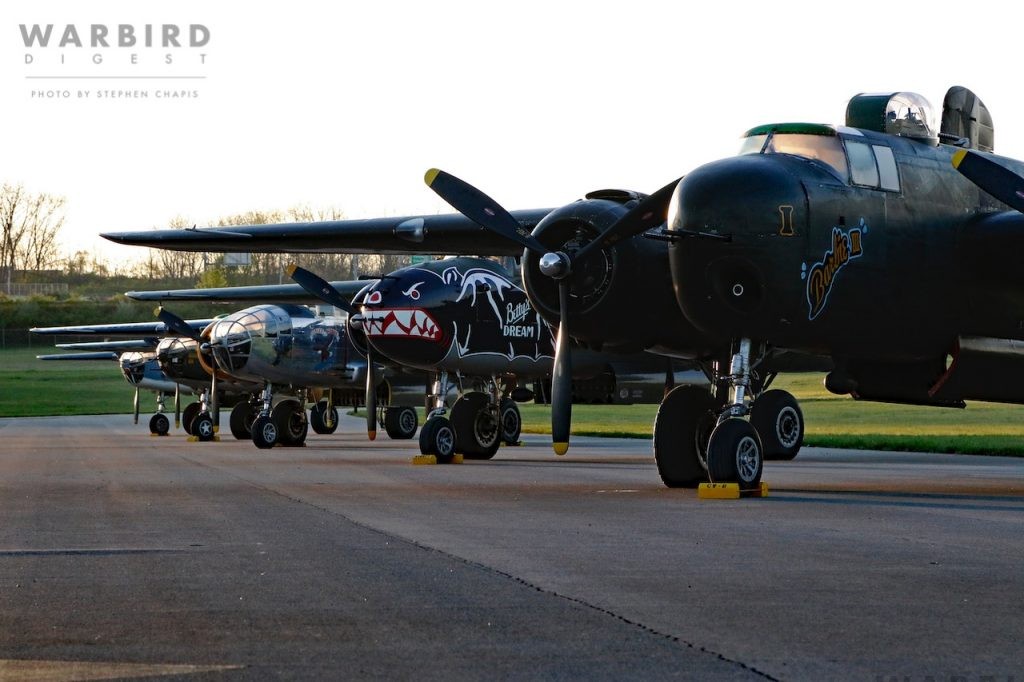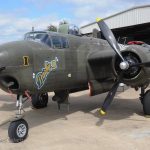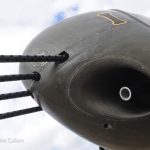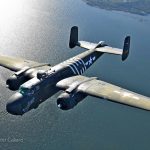By: Luigino Caliaro
Edited By: Stephen Chapis
Designed in 1939 by the North American Aviation Company (NAA) and baptized in honor of Major Gen. William “Billy” Mitchell (1879-1936), one of the first and most prominent supporters of American air power, the B-25 production run ran from 1940 and 1945. The two facilities, that produced the B-25, Inglewood, California and Kansas City, Kansas, turned out over 10,000 aircraft.
Amongst the many versions produced, without doubt the most significant were the G and H-models. The G-model featured a 75mm M4 cannon from the Sherman tank and four 50-caliber machine guns, which made this variant effective against small vessels, particularly barges carrying troops and cargo. The cannon was effective against ships as large as a destroyer.
The subsequent H-model was a notable improvement over the G, particularly in terms of defensive armament which included a tail turret and waist guns. In order to make room for the latter, the top turret was moved to the area just behind the flight deck. The H was also fitted with the lighter and more efficient T13E1 cannon, which resulted in the variant becoming a single-pilot aircraft as the co-pilot station was refitted for the navigator, who also served as the cannon operator. The first 300 B-25Hs were equipped with a quartet of 50-caliber machine guns in the nose as well as an additional pair in a dual blister pack on the right side of the fuselage. The subsequent 700 examples featured identical blister packs on the left side. When that octet of forward firing 50s were combined with the pair in the top turret, the H-model became the most formidable strafer in the Army Air Forces. If the heavy hitting firepower of these ten guns were not enough, the B-25H could also carry eight 5-inch rockets under the wings.
BARBIE III
Of the 1,000 B-25Hs produced by NAA, only four survive today, and only one, B-25H-1-NA, USAAF #43-4106, the second H-model produced, remains airworthy. Completed at the Inglewood factory on August 25, 1943, the aircraft as delivered to Eglin Field, Florida where it was used for stress and armament tests. It was declared surplus on December 6, 1945, and relegated to storage at Walnut Ridge, Arkansas.
In May 1946, under a government program, it was passed to the Oklahoma Agricultural and Mechanical College in Stillwater, Oklahoma. In 1951, it went to the Bendix Aviation Corporation of Detroit, in Michigan, where it was used for the testing of undercarriages and automatic pilot systems for the military. In 1967, it was sold to Barber’s Flying Service and just four years later, it was acquired by Richard Lambert of Plainfield, Illinois, an aviation enthusiast who had a private airstrip dubbed “Lambert Field”. Other than occasional taxi runs, the Mitchell languished for a decade.
After it was acquired to the Weary Warriors Squadron of Chicago, Illinois, in 1981, it was brought up to somewhat of a ferriable condition. While en route to Chicago, the aircraft suffered an engine failure and landed in Springfield, Illinois, where it was subjected to an initial restoration in preparation for a subsequent transfer by truck to Rockford, Illinois, where it would be subjected to a full restoration that would last a full decade. During the process, the center section of ‘4106 was replaced by that of B-25J, USAAF #44-28765 as well as components from other B-25s. The only departure with original B-25H is in the cockpit, which contains a traditional co-pilot station.
When the aircraft emerged from the restoration it was wearing the markings of B-25H USAAF #43-4380, Barbie III, as it appeared in service with the 1st Air Commando Group (ACG) while based at Hailakanidi Field, India, part of the China-Burma-India Theater, in 1944. This aircraft was the personal mount of the group commander Lieutenant Colonel Robert “R.T.” Smith, one of the first pilots to serve in the American Volunteer Group. In June 2009, the bomber was acquired by History Flight Inc., which used the aircraft for numerous promotional tours and participated in numerous air shows in the U.S. before it was sold to its current owner, Cavanaugh Flight Museum in Addison, Texas.
The paint scheme was faithfully recreated with dark olive-green upper surfaces and neutral grey undersides. Its fuselage featured the classic five diagonal white stripes, identifying it as belonging to the 1st ACG, which essentially had the function of providing visual identification of the American aircraft, but which also represented the five operational elements of the unit.
THE ORIGINAL “BARBIE III”
The official identity of the original Barbie III was B-25H-NA-1, USAAF #43-4380, and when it arrived in India, it was made Lt. Col. Smith’s personal aircraft and as was his tradition, he named the bomber after his new wife, Barbara Bradford, who he married shortly before leaving for the CBI in June 1943. Lt. Col. Smith ultimately flew 55 combat missions at the controls of Barbie III and earned the Silver Star.
In April 2017, a dozen B-25s gathered at Grimes Field in Urbana, Ohio to commemorate the 75th anniversary of the Doolittle Raid. With World War II seven decades behind us, there are precious few veterans still with us and at Urbana that weekend there were a number of B-25 veterans in attendance, including Thomas Bristol, a tail gunner and Purple Heart recipient who flew 54 missions with the 1st ACG. So, it was quite apropos that Scott Glover flew Bristol aboard Barbie III. The original Barbie III disappeared, presumably scrapped, during or shortly after the war, but thanks to a host of enthusiasts over the decades the legend of the Air Commandos will live on for future generations.
Check out our article from 2012 about ‘Barbie’ in a convenient digital format, click HERE.
A special thanks to Luigino Caliaro for helping with the drafting of the article and the photos. FOr more information about Luigino’s work visit www.aerophoto.it




















































